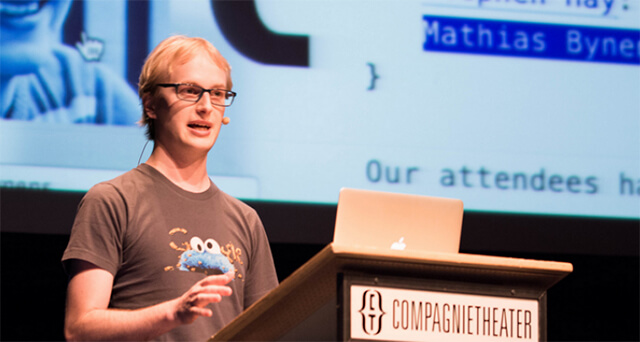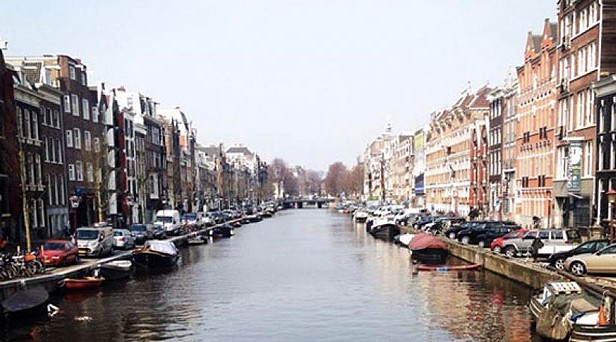In early June, three ducks (including me!) travelled to Amsterdam for a day filled with advanced CSS goodness. CSS Day is an intensive one-day-only conference for web developers, running for the second year. It is organised by the same people behind the brilliant Mobilism conference: Peter-Paul Koch, Krijn Hoetmer, Stephen Hay and Martijn van Duuren. This was one of the best conferences I’ve ever attended, and I’ve recapped the highlights of the day here.
The day started early at the Compagnietheater in the centre of a rainy Amsterdam; we were welcomed with plenty of good coffee, croissants and, for some reason, Nerf guns! The registration process was rather quick, so it went smoothly and the conference started in a timely manner.

Our fun Nerf-gun filled breakfast was a great way to start CSS Day.
The Talks
Stephen Hay opened the stage for the speakers, with the usual sponsor information and brief words to welcome all the attendees; please find more information about any of the brilliant speakers and talks I have recapped here on the CSS Day programme!
The first talk of the day came from Tab Atkins, who works for Google in the Chrome browser team. Tab demonstrated how the current CSS Layout modules work, and what we can expect in the following years. As one of the developers of today’s most popular browser, Tab knows the ins and outs of CSS implementation in Chrome first-hand!
After a short break, Ana Tudor took to the stage to teach us how to build amazing animated 3D shapes, made using only CSS. Ana’s impressive math and geometry skills, combined with her good eye for design, always results in a visually stunning representation of what is possible through experimenting with CSS.
David Baron, also from the browser industry, was next up. He gave a detailed description of how Mozilla Firefox handles animation performance; this was useful information, though I wish he’d included more advice on tools and how we could compile data from our own animations, as this would help us to make better design decisions.
Fuelled by a great selection of sandwiches, salad and pasta, we were ready to get going for the afternoon talks. Mathias Bynens’ “Fun Facts” was a fun, interesting talk to kick-start the second batch of speakers; it was filled with quirks of CSS and HTML, and lots of advice on how we can take advantage of them.
Peter-Paul Koch then took to the stage to share “The Mobile Viewports” and what they mean in CSS. Nowadays, browsing capable devices come in many forms and shapes, with many different screen resolutions. This talk was a great resource to make sense of the way these devices handle physical pixels vs. CSS pixels.
After the afternoon coffee break, Heydon Pickering presented another fun talk, full of small tricks and ideas to make good use of the advanced features of CSS; an example of this was how we could make use of smart selectors to enhance user experience without having to rely on using a complex CMS.
Ethan Marcotte, responsible for the term Responsive Web Design (RWD), closed the talks with a very inspiring presentation about the challenges of today’s web development scenarios. Ethan used the Pando, a giant tree with many ‘stems’ that resembles a forest, to create an analogy with the web, as each page is part of a massive network of content for us all to contribute. Finally, the conference closed with a discussion panel of all 8 speakers, which was mostly left open to all attendees (via Twitter) to gain answers for any burning questions, which came out of their individual sessions!
Conclusion
For me, this was one of the best conferences I’ve attended. The amount and quality of the information was so good that I feel I came away with lots of new ideas and things to try when I got back to the office! At Cyber-Duck, we value this type of experience and training very highly, as it has proven to bring very positive results for the team.
As the youngest developer in our team, John had a slightly different perspective on the event: “Being new to the industry, it was great to hear where some of the top CSS professionals have come from, and how they have worked their way into developing the future of CSS. One of the main things I will take from the conference is to always find time to do fun and exciting experiments with code, whether that’s a cool 3D transform or finding efficient ways to code your website. From listening to the Q&A session at the end, I was also able to relate to the issues people were having on a day-to-day basis and how the future of CSS is set to accommodate this”.
Similarly, Cynthia enjoyed the day, as it combined her abilities in development and QA: “CSS Day for me was very insightful, as it helped me to see the fun side of CSS and really appreciate how powerful language it is. As I am a young mind, trying to gain as much knowledge as I can from the veterans in this business, the aim for me was to leave with as many new directions of CSS to explore as possible, as well as solutions for the way I work today. I can happily say I achieved just that! More importantly, I found that all the talks (including the Q & A session at the end), showed me how there is not just one right way to enhance your code but many different ways to always find room for improvement”.




